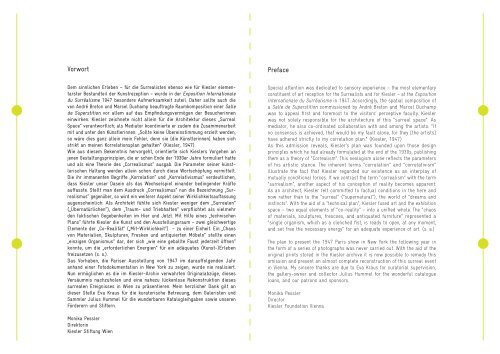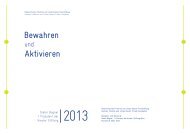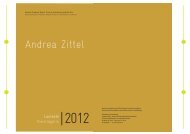Download - Ãsterreichische Friedrich und Lillian Kiesler Privatstiftung
Download - Ãsterreichische Friedrich und Lillian Kiesler Privatstiftung
Download - Ãsterreichische Friedrich und Lillian Kiesler Privatstiftung
Erfolgreiche ePaper selbst erstellen
Machen Sie aus Ihren PDF Publikationen ein blätterbares Flipbook mit unserer einzigartigen Google optimierten e-Paper Software.
Vorwort<br />
Preface<br />
Dem sinnlichen Erleben – für die Surrealisten ebenso wie für <strong>Kiesler</strong> elementarster<br />
Bestandteil der Kunstrezeption – wurde in der Exposition Internationale<br />
du Surréalisme 1947 besondere Aufmerksamkeit zuteil. Daher sollte auch die<br />
von André Breton <strong>und</strong> Marcel Duchamp beauftragte Raumkomposition einer Salle<br />
de Superstition vor allem auf das Empfindungsvermögen der Besucherinnen<br />
einwirken. <strong>Kiesler</strong> zeichnete nicht allein für die Architektur dieses „Surreal<br />
Space“ verantwortlich; als Mediator koordinierte er zudem die Zusammenarbeit<br />
mit <strong>und</strong> unter den Künstlerinnen: „Sollte keine Übereinstimmung erzielt werden,<br />
so wäre dies ganz allein mein Fehler, denn sie [die Künstlerinnen] haben sich<br />
strikt an meinen Korrelationsplan gehalten“ (<strong>Kiesler</strong>, 1947).<br />
Wie aus diesem Bekenntnis hervorgeht, orientierte sich <strong>Kiesler</strong>s Vorgehen an<br />
jenen Gestaltungsprinzipien, die er schon Ende der 1930er Jahre formuliert hatte<br />
<strong>und</strong> als eine Theorie des „Correalismus“ ausgab. Die Parameter seiner künstlerischen<br />
Haltung werden allein schon durch diese Wortschöpfung vermittelt.<br />
Die ihr immanenten Begriffe „Korrelation“ <strong>und</strong> „Korrelativismus“ verdeutlichen,<br />
dass <strong>Kiesler</strong> unser Dasein als das Wechselspiel einander bedingender Kräfte<br />
auffasste. Stellt man dem Ausdruck „Correalismus“ nun die Bezeichnung „Surrealismus“<br />
gegenüber, so wird ein weiterer Aspekt seiner Wirklichkeitsauffassung<br />
augenscheinlich: Als Architekt fühlte sich <strong>Kiesler</strong> weniger dem „Surrealen“<br />
(„Übernatürlichen“), dem „Traum- <strong>und</strong> Triebhaften“ verpflichtet als vielmehr<br />
den faktischen Gegebenheiten im Hier <strong>und</strong> Jetzt. Mit Hilfe eines „technischen<br />
Plans“ führte <strong>Kiesler</strong> die Kunst <strong>und</strong> den Ausstellungsraum – zwei gleichwertige<br />
Elemente der „Co-Realität“ („Mit-Wirklichkeit“) – zu einer Einheit. Ein „Chaos<br />
von Materialien, Skulpturen, Fresken <strong>und</strong> antiquierten Möbeln“ stellte einen<br />
„einzigen Organismus“ dar, der sich „wie eine geballte Faust jederzeit öffnen“<br />
konnte, um die „erforderlichen Energien“ für ein adäquates (Kunst-)Erleben<br />
freizusetzen (s. o.).<br />
Das Vorhaben, die Pariser Ausstellung von 1947 im darauffolgenden Jahr<br />
anhand einer Fotodokumentation in New York zu zeigen, wurde nie realisiert.<br />
Nun ermöglichen es die im <strong>Kiesler</strong>-Archiv verwahrten Originalabzüge, dieses<br />
Versäumnis nachzuholen <strong>und</strong> eine nahezu lückenlose Rekonstruktion dieses<br />
surrealen Ereignisses in Wien zu präsentieren. Mein herzlicher Dank gilt an<br />
dieser Stelle Eva Kraus für die kuratorische Betreuung, dem Galeristen <strong>und</strong><br />
Sammler Julius Hummel für die w<strong>und</strong>erbaren Katalogleihgaben sowie unseren<br />
Förderern <strong>und</strong> Stiftern.<br />
Special attention was dedicated to sensory experience – the most elementary<br />
constituent of art reception for the Surrealists and for <strong>Kiesler</strong> – at the Exposition<br />
Internationale du Surréalisme in 1947. Accordingly, the spatial composition of<br />
a Salle de Superstition commissioned by André Breton and Marcel Duchamp<br />
was to appeal first and foremost to the visitors’ perceptive faculty. <strong>Kiesler</strong><br />
was not solely responsible for the architecture of this “surreal space”. As<br />
mediator, he also co-ordinated collaboration with and among the artists: “If<br />
no consensus is achieved, that would be my fault alone, for they [the artists]<br />
have adhered strictly to my correlation plan.” (<strong>Kiesler</strong>, 1947)<br />
As this admission reveals, <strong>Kiesler</strong>’s plan was fo<strong>und</strong>ed upon those design<br />
principles which he had already formulated at the end of the 1930s, publishing<br />
them as a theory of “Correalism”. This neologism alone reflects the parameters<br />
of his artistic stance. The inherent terms “correlation” and “correlativism”<br />
illustrate the fact that <strong>Kiesler</strong> regarded our existence as an interplay of<br />
mutually conditional forces. If we contrast the term “correalism” with the term<br />
“surrealism”, another aspect of his conception of reality becomes apparent:<br />
As an architect, <strong>Kiesler</strong> felt committed to factual conditions in the here and<br />
now rather than to the “surreal” (“supernatural”), the world of “dreams and<br />
instincts”. With the aid of a “technical plan”, <strong>Kiesler</strong> fused art and the exhibition<br />
space – two equal elements of “co-reality” – into a unified whole. The “chaos<br />
of materials, sculptures, frescoes, and antiquated furniture” represented a<br />
“single organism, which as a clenched fist, is ready to open, at any moment,<br />
and set free the necessary energy” for an adequate experience of art. (s. a.)<br />
The plan to present the 1947 Paris show in New York the following year in<br />
the form of a series of photographs was never carried out. With the aid of the<br />
original prints stored in the <strong>Kiesler</strong> archive it is now possible to remedy this<br />
omission and present an almost complete reconstruction of this surreal event<br />
in Vienna. My sincere thanks are due to Eva Kraus for curatorial supervision,<br />
the gallery-owner and collector Julius Hummel for the wonderful catalogue<br />
loans, and our patrons and sponsors.<br />
Monika Pessler<br />
Director<br />
<strong>Kiesler</strong> Fo<strong>und</strong>ation Vienna<br />
Monika Pessler<br />
Direktorin<br />
<strong>Kiesler</strong> Stiftung Wien








